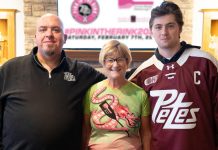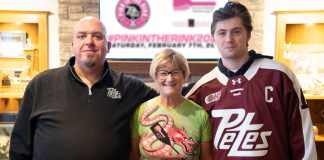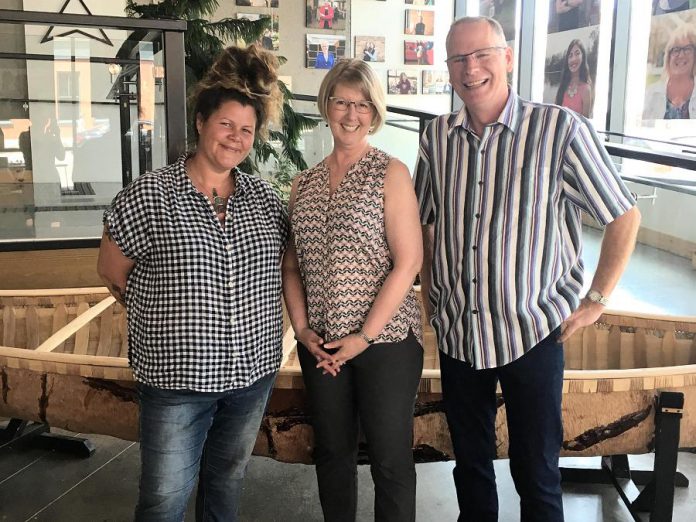
The Downtown Vibrancy Project is now in its second year and this year we hosted many design sessions with local residents, First Nations communities, and local business. We discussed what the canoe means to us all and how public art in our downtown could represent that connection.
In those design sessions, we heard about how Peterborough is known as Nogojiwanong (“the place at the foot of the rapids”), which is part of the territories of the Michi Saagiig Anishinaabe Peoples.
From popular paddling and portage routes, to canoe building, this area is rich with canoe history.
The culture of the Michi Saagiig Anishinaabe Peoples and their traditional connection with canoe travel in this area were themes that our community felt should be represented more prominently in our downtown.
We are thrilled to see this partnership between the Downtown Business Improvement Area (DBIA) and GreenUP’s Depave Paradise project result in a new pocket park on the corner of King Street and Water Street. This new greenspace will soon also showcase two canoe-themed public art pieces created by local Anishinaabe artist Tia Cavanagh.
The name of the park was also created by the community. Jiimaan’ndewengadnong (“the place where the heart of the canoe beats”) is a beautiful Mizi-Zaagiing Anishinabeg phrase translated by Elder Mary Taylor and Jack Hoggarth, Cultural Archivist, both from Curve Lake First Nation.
As the Downtown Vibrancy Project Coordinator, I am privileged to have listened to many personal stories about canoeing and people’s connection to water. Some of these storytellers gave permission to record and share their stories to a wider audience. This article is dedicated to one of their stories.
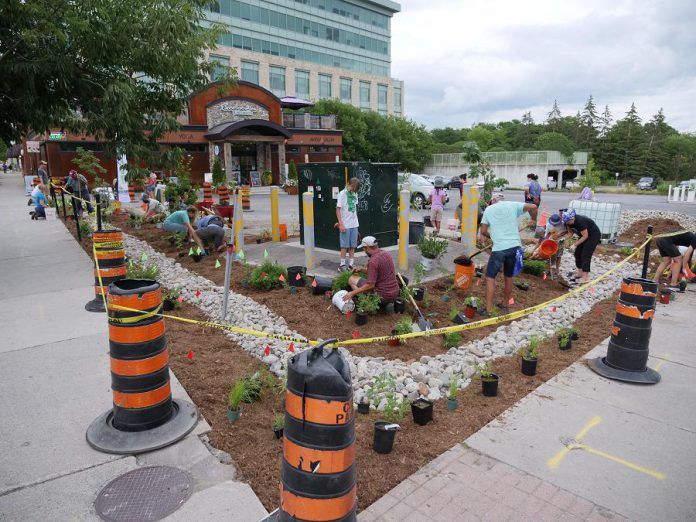
Interview with artist Tia Cavanagh
Tia Cavanagh is the talented artist creating the art for the Jiimaan’ndewemgadnong pocket park. Tia is an accomplished artist who has created public art in Toronto and recently she created a mural for Trent University.
We sat down together this spring and I asked what the canoe means to her. She shared her experience co-organizing an inclusive birchbark canoe build in Curve Lake with her friend Madeline Whetung.
“We applied to the Ontario Arts Council Grant, Indigenous Education Fund, which was actually only running for one year,” Tia says. “It’s important to pay people for their skills. We did find a (birchbark canoe) builder — his name is Chuck Commanda — who does tons and tons of builds. He’s really quite a producer and it’s his livelihood.”
“And really what was important to us was to communicate to him was that we wanted this build to centre around two-spirit and Indigenous women in the creation of this canoe.”
Chuck Commanda is a master birchbark canoe builder from the community of Kitigan Zibi, Quebec. He has been building canoes since he was a child, as a student of his highly respected grandparents, Mary and William Commanda. He has spent more than 10 years building canoes in the traditional style and teaching others the craft.
“Madeline Whetung and I wanted to be his assistants. We really wanted to learn. It was really about us gaining that knowledge and then creating that opportunity for other folks to join in and build and learn as well. We really wanted our own knowledge to be uplifted.”
The season for canoe building
“It was a speedy build,” Tia explains. “Our builder was on quite a tight timeline, and had another build scheduled. That’s how he makes a living and acquiring birchbark and all that — you can only really do it during certain times. I mean, there are things that can be made with winter bark.”
“But for a birchbark canoe, we really needed to prepare the birchbark throughout a warmer temperature — 25 Celsius or higher is the best temperature to acquire birchbark for a summer canoe. So it’s about two weeks, the build itself. And really, it was every day — every day from nine o’clock to about five.”
An endangered cultural practice
“The birchbark itself, we got it and prepared it close to Algonquin Park,” Tia says. “When we hired the builder, Chuck, basically he’s responsible for finding that tree. So we were listening in, and experiencing, and we saw the difficulties he had in doing so.”
“Considering the quality of birch trees right now is important, because certain diseases are taking over them. We wanted to find one quite big. For most adult people, it needs to be big enough that you can reach your arm around and not quite touch your hands.”
“Considering the state of our forests, the kind of disease that some trees are suffering from and the fact that now a lot of birch trees, when they get to a certain age, just die. I think it’s becoming more and more rare — having only a handful of folks in this area that are able, and that have the knowledge, to build a birchbark canoe, coupled with the fact that some of these very large and healthy birch trees are really few and far between.”
“There’s this kind of endangered quality to it which makes it even more special.”
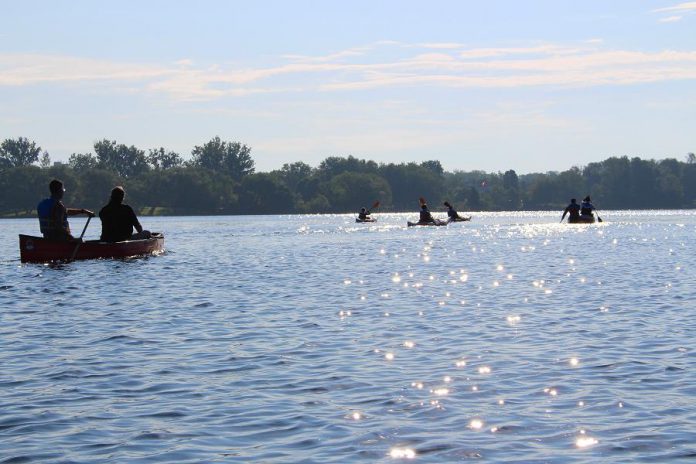
Sealing the Canoe
Tia told me that, once the canoe is built, it needs to be made watertight with a natural gum sealant made from tree sap. She explained that this process requires skill.
“The tree sap is collected, then it has to be cleaned and rendered with a couple other things added to it. There are different recipes out there. And that’s one thing that I’m not that educated on making … but I did see a couple of recipes recently that looked to be really good. And it’s really an art form creating it.”
Tia’s favourite lesson from the canoe building experience is the fact that birchbark canoes are made from parts of many tree species.
“There are various other trees that go into making a birchbark canoe. And yet we call it a birchbark canoe, right? Because aesthetically, you see the birchbark, but spruce sap comes into it, and cedar, and hardwood, like oak. So I think that is what’s really special to consider, that all of these different trees have different properties that they add to a birchbark canoe.”
Tia and Madeline’s canoe is now built and has been featured in one of Tia’s artworks.
“Madeline and I would love to do a trip or two,” Tia says. “Madeline has a lot of knowledge of waterways and the lock system.”
More canoe stories and local support for the Jiimaan’ndewemgadnong project
Follow @PtboGreenUP on social media to be notified when audio of Tia’s story and more canoe stories will be available on our website at greenup.on.ca/vibrancy.
When completed, audio of these interviews will also be available to visitors at the Jiimaan’ndewemgadnong pocket park by calling the phone numbers on the park plaques.
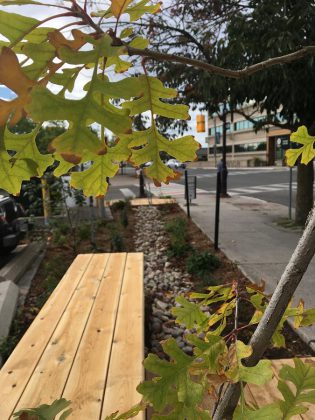
This kind of remarkable, authentic project doesn’t happen without a lot of collaboration and generous support.
First and foremost, chi miigwech to Tia Cavanagh, Madeline Whetung, Shirley Williams, and Terry Musgrave for sharing their stories.
Thanks to Nexicom and Impact Communications for donating their time and skills to make the audio interviews available.
Thanks to the support of Lett Architects, Engage Engineering, Tree House Timberworks, Accurex, Coco Paving, Ralph’s Paving, Alderville Black Oak Savanna, The Food Shop, The Silver Bean café, and many more.
The space itself has been generously made accessible to the public by Euphoria Wellness Spa, and the art installation was also generously sponsored by Kim and Mark Zippel.
This project is also part of a larger movement led by Green Communities Canada and their national Depave Paradise Initiative. Funding for this project was provided by the Ontario Trillium Foundation. The Jiimaan’ndewemgadnong pocket park and Downtown Vibrancy Project are a partnership between the Downtown Business Improvement Area (DBIA) and GreenUP’s Depave Paradise project.
If you are interested in supporting the project by donating services or providing sponsorship, please email Dawn Pond at dawn.pond@greenup.on.ca for more details.


